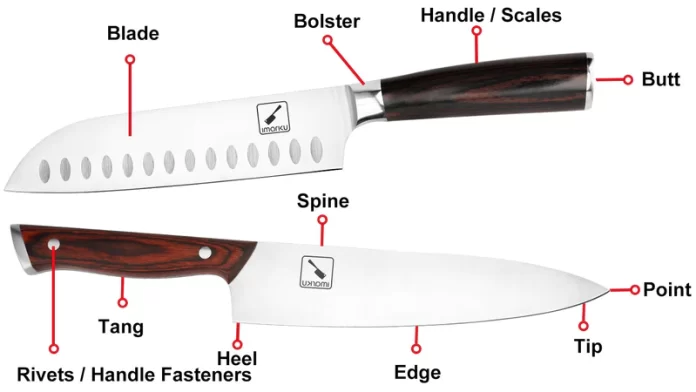A knife is a versatile tool that can be used for various purposes such as cooking, hunting, and self-defense. To use a knife effectively, it is essential to understand its anatomy and the different parts of the blade. In this article, we will explore the anatomy of a knife and its different components. We will also discuss the purpose and function of each part of the blade.
Introduction
Knives have been used by humans for thousands of years, and they have evolved over time to become an essential tool in our daily lives. From the kitchen to the great outdoors, knives serve various purposes, and their design and construction have become more intricate and specialized. Understanding the anatomy of a knife is crucial to using it correctly and maintaining its longevity.
The Blade
The blade is the most critical part of the knife, and it is made up of several components. Let’s take a closer look at each part.
Point
The point of the blade is the sharp end that tapers to a fine point. The point is used for piercing and detail work, and it comes in different shapes and sizes, such as clip point, spear point, and drop point.
Tip
The tip is the end of the blade opposite the handle. The tip is used for delicate and precise cutting and can come in a variety of shapes, such as straight, curved, or hooked.
Edge
The edge is the sharpened side of the blade that is used for cutting with sword uk. The edge can be either serrated or plain, depending on the intended use of the knife. A serrated edge is ideal for cutting through tough materials such as bread, while a plain edge is better for slicing through meat and vegetables.
Spine
The spine of the blade is the thickest and widest part of the blade, and it runs parallel to the edge. The spine provides structural support to the blade and can be used for crushing or grinding.
Heel
The heel is the part of the blade closest to the handle. The heel is used for chopping and cutting through hard materials.
Bolster
The bolster is the thick metal portion of the blade that separates the blade from the handle. The bolster provides balance and stability to the knife and can also be used for protection.
The Handle
The handle is the part of the knife that you hold onto while using it. It is made up of several components, each with its own function.
Tang
The tang is the part of the blade that extends into the handle. A full tang runs the entire length of the handle, while a partial tang runs only partway. A full tang provides better balance and durability to the knife.
Scales
The scales are the two pieces of material that make up the handle. They can be made from a variety of materials such as wood, plastic, or bone. The scales provide grip and comfort while using the knife.
Butt
The butt is the end of the handle opposite the blade. The butt can be used for striking or pounding and can also be used as a counterbalance to the blade.
Rivets
The rivets are the metal pins that hold the handle scales in place. The number of rivets can vary depending on the knife’s size and construction.
Knowing the different parts of the blade and their functions can also help you choose the right knife for the job. It is important to invest in a high-quality knife that is well-constructed and properly maintained to ensure its longevity.
When using a knife, it is crucial to practice proper safety precautions to avoid injury. Always keep your fingers away from the blade and use a cutting board to protect your countertop.
In conclusion, the anatomy of a knife consists of the blade and the handle, each with its own parts and functions. Understanding the different components of a knife can help you use it more effectively and choose the right knife for the task at hand.
FAQs
- What is the purpose of the bolster in a knife? The bolster provides balance and stability to the knife and can also be used for protection.
- What is a full tang? A full tang is the part of the blade that extends into the handle, running the entire length of the handle. It provides better balance and durability to the knife.
- What is the difference between a serrated and a plain edge? A serrated edge is ideal for cutting through tough materials such as bread, while a plain edge is better for slicing through meat and vegetables.
- How do I maintain the longevity of my knife? It is important to invest in a high-quality knife, properly maintain it, and practice proper safety precautions when using it.
- What is the purpose of the butt of a knife handle? The butt of a knife handle can be used for striking or pounding and can also be used as a counterbalance to the blade.





